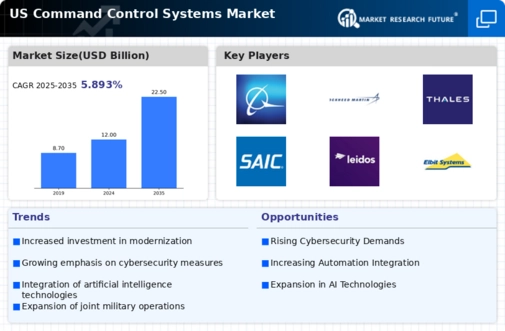Increased Defense Spending
The command control-systems market is likely to benefit from heightened defense spending in the United States. With geopolitical tensions on the rise, the U.S. government has allocated substantial budgets to enhance military capabilities. In 2025, defense spending is projected to exceed $800 billion, with a significant portion directed towards upgrading command control systems. This investment is aimed at improving situational awareness and decision-making processes in military operations. As a result, defense contractors are increasingly focusing on developing innovative solutions tailored to meet the evolving needs of the armed forces. This influx of funding is expected to propel the command control-systems market forward, fostering advancements in technology and operational effectiveness.
Emphasis on Training and Simulation
The command control-systems market is significantly influenced by the emphasis on training and simulation technologies. As organizations recognize the importance of preparedness, there is a growing investment in simulation-based training programs. These programs allow personnel to practice decision-making and operational procedures in a controlled environment, enhancing their readiness for real-world scenarios. The market for training and simulation solutions is projected to reach $5 billion by 2026, reflecting a strong commitment to improving operational capabilities. This focus on training not only enhances the effectiveness of command control systems but also ensures that personnel are well-equipped to utilize these systems efficiently in high-pressure situations.
Growing Demand for Integrated Solutions
The command control-systems market is witnessing a growing demand for integrated solutions that combine various functionalities into a single platform. Organizations are increasingly seeking systems that can manage communication, data analysis, and operational coordination seamlessly. This trend is particularly evident in sectors such as public safety and defense, where the need for cohesive operations is paramount. The market for integrated command control systems is anticipated to grow at a CAGR of 12% over the next five years. This shift towards comprehensive solutions is driven by the desire to enhance efficiency and reduce response times in critical situations, thereby reinforcing the importance of integrated systems in the command control-systems market.
Regulatory Compliance and Standardization
Regulatory compliance and standardization requirements are increasingly shaping the command control systems market. Government agencies are implementing stringent guidelines to ensure that command control systems meet specific operational and security standards. This regulatory landscape is driving organizations to invest in compliant systems that can adapt to evolving requirements. As a result, the market is expected to see a rise in demand for systems that not only fulfill operational needs but also adhere to regulatory frameworks. This trend is likely to foster innovation within the command control-systems market, as companies strive to develop solutions that align with compliance mandates while enhancing overall system performance.
Technological Advancements in Communication
The command control-systems market is experiencing a surge due to rapid advancements in communication technologies. Enhanced data transmission capabilities, such as 5G and satellite communications, are enabling real-time information sharing among command centers. This is crucial for military and emergency response operations, where timely decisions can save lives. The integration of advanced communication systems is projected to increase operational efficiency by up to 30%. As organizations seek to modernize their command control capabilities, investments in these technologies are expected to rise significantly, potentially reaching $10 billion by 2027. This trend indicates a robust growth trajectory for the command control-systems market, driven by the need for seamless communication in critical situations.



















Leave a Comment